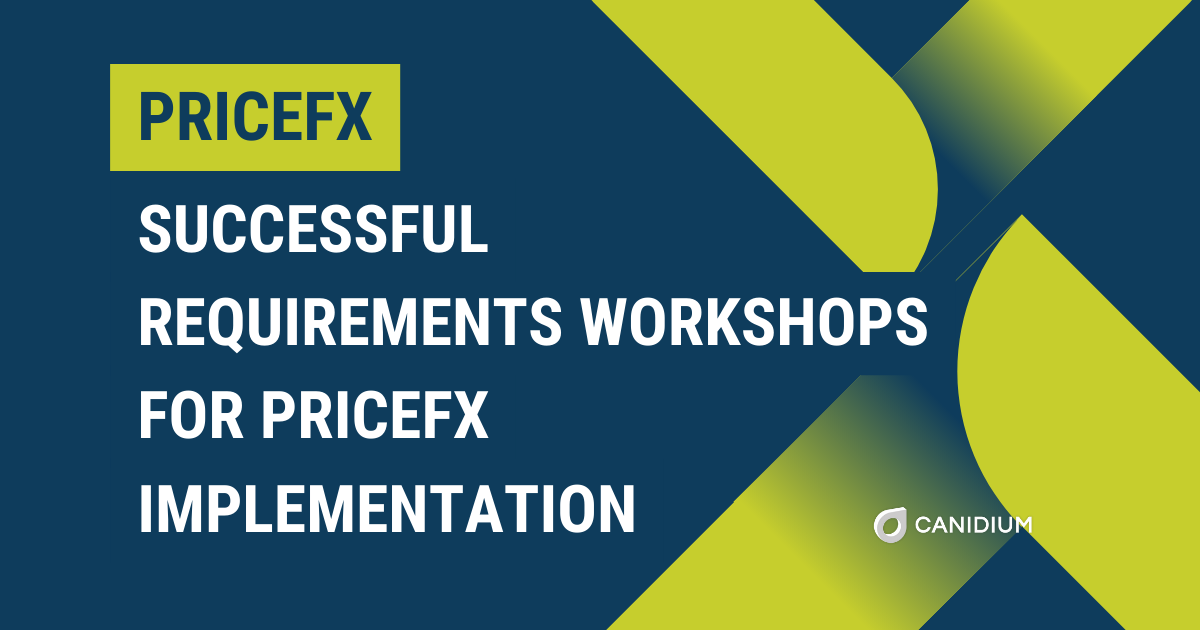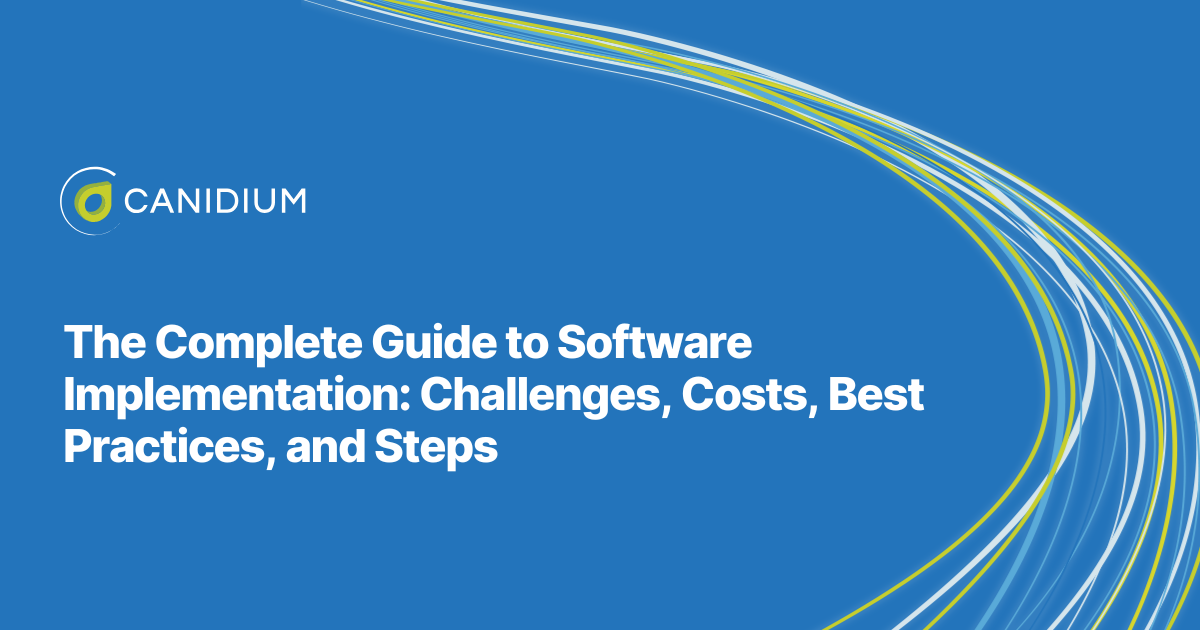The good news: You have done the hard work of finding a pricing solution. 🎉
The bad news: The work is only just beginning. 😅
The next major hurdle is finding a software implementation (SI) Partner and performing a functional requirements document (FRD) workshop. Every SI Partner will do this differently. But at Canidium, it's a highly hands-on and structured process.
PriceFX implementation hinges on the meticulous gathering of functional requirements. Crafting a structured and collaborative workshop is critical to achieving this goal. In this article, we explain:
- What a requirements workshop is
- Structure of Canidium's Requirements workshops
- Key stakeholders that should be involved in your Requirements workshop
- How to measure the success of a Requirements Workshop
- How stakeholders contribute to the Requirements workshop
What is a Requirements Workshop?
An FRD or Functional Requirements Document workshop is a collaborative session conducted during the early stages of a software or system implementation project. Its primary purpose is to gather and document detailed functional requirements that will guide the development and implementation of the solution. The Functional Requirements Document (FRD) serves as a blueprint, outlining what the system or software is expected to accomplish and how it should function.
Insights from Chris Keenan, Go-To Market Lead, PriceFX: Industry-specific Challenges
Chris Keenan emphasizes that each industry faces its own unique pricing challenges, often tied to the change of underlying goods. For instance, companies in the chemicals or commodity space may adjust pricing based on the daily or hourly changes in the prices of goods. Freight costs, influenced by fluctuations in gas prices, are also significant drivers. Understanding these industry-specific challenges is crucial during the requirements workshop.
Typical Structure of a PriceFX Requirements Workshop
Structuring a functional requirements workshop for a PriceFX implementation involves careful planning and organization to ensure that key stakeholders can effectively contribute to gathering requirements. Here is a suggested structure for a functional requirements workshop:
Pre-Workshop Preparation
Define Objectives: Clearly outline the workshop's objectives, specifying what needs to be achieved during the session.
Identify Participants: Determine the key stakeholders and participants who should attend the workshop based on their roles and expertise.
Distribute Pre-Workshop Materials: Send relevant documentation, such as existing business processes, system documentation, and requirements templates, to participants beforehand.
Introduction and Overview
Welcome and Agenda Review: Open the workshop with a welcome and overview of the agenda. Briefly review the goals and expected outcomes.
Icebreaker or Team-building Activity: Consider incorporating a brief icebreaker or team-building activity to set a positive and collaborative tone.
Context Setting
Business Context Presentation: Provide a presentation on the current business context, market conditions, and industry trends affecting pricing strategies.
Review Business Objectives: Discuss and clarify the overall business objectives related to pricing that the PriceFX implementation aims to address.
Requirements Elicitation
User Stories and Scenarios: Use interactive sessions to elicit user stories and scenarios from participants. Capture real-world situations that illustrate how the PriceFX solution will be used.
Brainstorming Sessions: Conduct brainstorming sessions to gather ideas and input on specific features, functionalities, and workflows required for effective pricing.
Prioritization Exercises: Work with participants to prioritize requirements based on business impact, urgency, and strategic importance.
Documentation and Validation
Documentation Workstations: Set up workstations for documentation, allowing participants to contribute directly to the documentation of requirements.
Validation and Review: Periodically review and validate the documented requirements with participants to ensure accuracy and completeness.
Technical Alignment
Collaboration with IT Teams: Facilitate discussions between business stakeholders and IT teams to ensure technical requirements align with the capabilities of the PriceFX platform.
Technical Feasibility Assessment: Conduct a technical feasibility assessment to identify any constraints or considerations that may impact the implementation.
Decision-Making and Trade-offs
Decision Points: Identify key decision points related to pricing strategies, configurations, and any necessary trade-offs.
Collaborative Decision-Making: Facilitate collaborative decision-making processes, ensuring that stakeholders are actively involved in shaping the solution.
Chris notes that stakeholder creep can occur, introducing new elements as the project progresses. To counter this, he emphasizes the importance of working closely with key stakeholders from the beginning, identifying the top priorities, and staying laser-focused on solving specific challenges.
Closing and Next Steps
Summary of Workshop Outcomes: Provide a summary of the workshop outcomes, highlighting critical decisions and agreed-upon requirements.
Next Steps and Action Items: Outline the next steps in the implementation process and assign action items to relevant stakeholders.
Post-Workshop Follow-Up
Documentation Distribution: Distribute the finalized requirements documentation to participants for review and feedback.
Follow-Up Meetings: Schedule follow-up meetings to address any additional questions or concerns and to provide updates on the implementation progress.
By following this structured approach, you can create a productive and collaborative environment for gathering functional requirements for the PriceFX implementation. Adjust the structure based on the specific needs and dynamics of your organization.
Key Stakeholders to Involve in Your PriceFX Requirements Workshop
In a PriceFX implementation, involving key stakeholders from various departments is crucial to ensure that the functional requirements workshop captures a comprehensive view of the organization's needs. Here are the key stakeholders to involve in the workshop:
Sales Team: Sales representatives and managers can provide insights into pricing strategies, discounting policies, and customer segmentation.
Finance Department: Financial experts can offer information on budget constraints, cost structures, and financial models that must be considered in pricing strategies.
IT Department: IT professionals are critical in implementing and maintaining the PriceFX solution. Their input is essential to ensure technical feasibility and alignment with existing systems.
Marketing Team: Marketing experts can provide information on promotional strategies, market trends, and customer behavior, impacting pricing decisions.
Product Management: Product managers can contribute insights into product lifecycles, features, and differentiation strategies that may affect pricing.
Customer Service/Support: Customer service or support representatives can provide information on customer feedback, common issues, and any requirements related to pricing adjustments for customer satisfaction.
Legal and Compliance: Legal experts can ensure pricing strategies comply with regulations and industry standards. They can also advise on contractual considerations.
Supply Chain Management: Teams involved in supply chain management can provide insights into procurement costs, inventory management, and supply chain dynamics affecting pricing.
Executive Leadership: The involvement of top-level executives is crucial to align the pricing strategy with overall business objectives and to secure necessary resources for implementation.
Data Analytics/BI Teams: Data experts can assist in gathering and analyzing relevant data to support pricing decisions. They can also provide insights into reporting and analytics requirements.
Human Resources: HR representatives can provide information on training needs, organizational change management, and any impacts on personnel due to the PriceFX implementation.
End Users: Include representatives from teams that will directly use the PriceFX solution. Their input ensures that the system meets user requirements and enhances user adoption.
By involving these key stakeholders in the functional requirements workshop, you can gather diverse perspectives, ensure buy-in from relevant departments, and increase the likelihood of a successful PriceFX implementation that meets the entire organization's needs.
9 Ways Stakeholders Can Contribute to Your PriceFX Requirements Workshop
Stakeholder involvement in a functional requirements workshop for a PriceFX implementation ensures that the solution aligns with the organization's needs and objectives. Here are various ways stakeholders can actively participate in the workshop:
1. Attend Workshops and Sessions: Stakeholders should actively attend the functional requirements workshops and sessions to provide firsthand input and insights into their specific areas of expertise.
Provide Business Context: Share knowledge about the business context, market conditions, and industry trends that may impact pricing strategies. This creates a solution that aligns with broader business objectives.
Clarify Business Objectives: Clearly articulate business objectives and goals related to pricing. This information guides the development of functional requirements that support the organization's strategic direction.
Contribute to Requirements Definition: Actively participate in discussions to define functional requirements. Provide input on the specific features, functionalities, and workflows needed to meet business needs.
Offer Use Cases and Scenarios: Share real-world use cases and scenarios illustrating how the PriceFX solution will be used in daily operations. This helps in creating user stories and refining functional requirements.
Express Pain Points and Challenges: Communicate pain points, challenges, and existing issues related to the current pricing processes. This information is valuable for addressing specific needs during the implementation.
Validate and Approve Requirements: Review and validate the documented requirements during and after the workshop. Stakeholders should actively participate in the approval process to ensure accuracy and completeness.
Provide Data and Information: Supply relevant data and information required for configuring the PriceFX solution. This includes pricing, customer information, and other data for accurate implementation.
Engage in Decision-Making: Participate in decision-making processes related to pricing strategies, configurations, and any trade-offs necessary during the implementation.
By actively participating in these ways, stakeholders contribute to the success of the PriceFX implementation, fostering collaboration and ensuring that the final solution meets the organization's diverse needs.
Measuring Success in a Requirements Workshop
The success of a PriceFX implementation hinges on three crucial pillars: Documentation Quality, Prioritization, and Team Alignment. This section explores the significance of comprehensive documentation, strategic prioritization, and a well-aligned team during the requirements workshop. These pillars collectively lay the groundwork for a streamlined and successful PriceFX implementation journey.
-
Documentation Quality: Comprehensive documentation, whether in the form of an FRD, TDD, or user stories, is crucial. It captures functional requirements, technical specifications, and real-world scenarios identified during the requirements workshop. Quality documentation reduces ambiguity and ensures a shared understanding of the implementation scope.
-
Prioritization: Identifying and prioritizing the top three to five priorities is essential during the requirements workshop. This involves understanding critical business needs, evaluating urgency, and focusing on features or functionalities with the most significant impact. Prioritization helps manage the project scope, allocate resources effectively, and deliver value promptly.
-
Team Alignment: Ensuring key roles, including the product owner and project manager, are actively involved fosters team alignment. The product owner owns the requirements, aligning the solution with business needs, while the project manager coordinates activities and maintains project timelines. Team alignment, extending across departments, enhances collaboration and ensures a shared vision for the PriceFX implementation.
These three pillars—documentation quality, prioritization, and team alignment—form the foundation for a successful requirements workshop and, consequently, a streamlined PriceFX implementation process.
How to have an effective requirements workshop
A PriceFX implementation journey is an intricate process, and the success of this endeavor hinges on strategic decision-making and meticulous planning. As we've explored, a pivotal phase in this journey is the Functional Requirements Document (FRD) workshop, where the blueprint for the PriceFX solution is tailored to an organization's needs.
Chris shares that organizations entering requirements workshops should have a clear understanding of their project objectives, establish a realistic project plan, and ensure team alignment. Knowing the pain points, setting a target go-live date, and staying on track are essential components for a successful PriceFX implementation.
At Canidium, we approach this critical workshop with a highly hands-on and structured process, recognizing the significance of collaboration and clarity in achieving optimal outcomes. The structured approach outlined in this article guides organizations aiming to create a productive and collaborative environment during their PriceFX requirements workshops.
Now that you understand what an requirements workshop entails, the typical structure it should follow, the key stakeholders involved, and the active role stakeholders play in contributing to its success, your next step is to get in touch with our team to get going on yours.
Contact Our PriceFX Team








